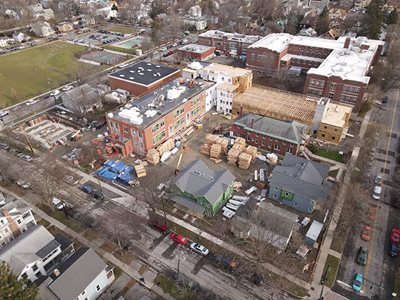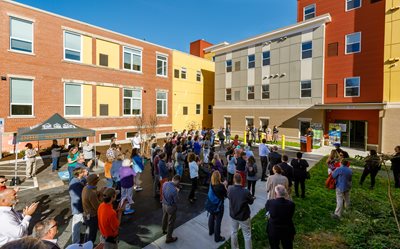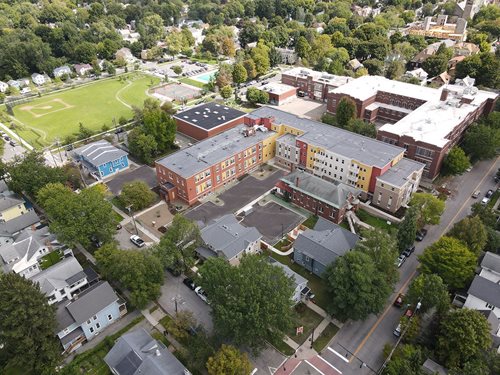In the coming weeks, NeighborWorks America will spotlight community development projects while highlighting how those projects came to be. This week, the focus is on Founders Way, a newly constructed affordable and supportive housing development in Ithaca, New York, developed by Ithaca Neighborhood Housing Services (INHS). Johanna Anderson, executive director of INHS, talked about the project.
Can you describe the scope of the project and how it started?
 Founders Way, going up. Photo/INHS
INHS purchased the former Immaculate Conception School property, located at 320 West Buffalo Street, from the Immaculate Conception Church in early 2019. (The school was closed at the end of the 2016-17 school year due to decreasing enrollment and increasing operating costs.) Founders Way is a mixed-use, mixed-income community, which was a strategic decision based on the fact that since Ithaca's housing market is so saturated, low-income families have a difficult time living close to schools, shops, human services and employment opportunities as transportation can be an issue and costly. We wanted to give them an opportunity to have safe, affordable housing in an area where they can access those basic human needs.
Founders Way, going up. Photo/INHS
INHS purchased the former Immaculate Conception School property, located at 320 West Buffalo Street, from the Immaculate Conception Church in early 2019. (The school was closed at the end of the 2016-17 school year due to decreasing enrollment and increasing operating costs.) Founders Way is a mixed-use, mixed-income community, which was a strategic decision based on the fact that since Ithaca's housing market is so saturated, low-income families have a difficult time living close to schools, shops, human services and employment opportunities as transportation can be an issue and costly. We wanted to give them an opportunity to have safe, affordable housing in an area where they can access those basic human needs.

Through adaptive re-use, one wing of the existing school preserved a circa 1850 Greek Revival house on the corner of Buffalo and Plain Streets, and restored the residential rhythm of the streetscape by constructing two new groups of rental townhomes along Buffalo and Plain. INHS also subdivided the former school gymnasium, which was sold to the City of Ithaca for use by Greater Ithaca Activities Center, as well as a parcel on the corner of Court and Plain Streets on which four affordable for-sale townhomes were constructed.
Founders Way opened in fall 2022.
What obstacles did you face along the way?
We did experience rising construction prices as did everyone else in a similar situation.
 The transformation of Founders Way. Photo/INHS
The transformation of Founders Way. Photo/INHS

What lessons did you learn while working on this project?
We continue to appreciate the value of a robust community engagement process and the support that open and honest communication engenders. The project includes non-residential space, which has been the case on other projects we've completed, but in this case, the particular equity investor required the formation of a condominium to separate the two portions of the project. This was a challenging structure to accommodate late in the closing process and added both expenses and complexity to an already complex project. In the future, we would have a contingency plan in place for this.

We used Capital Magnet Funds that INHS was awarded by the U.S. Department of the Treasury. These funds were only available to us because of our status as a Community Development Financial Institution. We used these on both the residential portion of the project (low- to moderate-income housing in a distressed area) and the commercial portion (economic development activity).
Any special features or details you’d like to highlight?
A mural, designed by a local artist in conjunction with the first-grade class of the adjacent elementary school! The mural enlivens what otherwise would have been a fairly tall, uninteresting wall facing the school's playground.
How does this project make a difference in your area?
INHS strives to build affordable housing that is accessible, sustainable and high-quality in areas where housing is desperately needed due to unaffordable rents or for-sale homes, deteriorating housing stock, and limited housing opportunities.
– Madelyn Lazorchak

